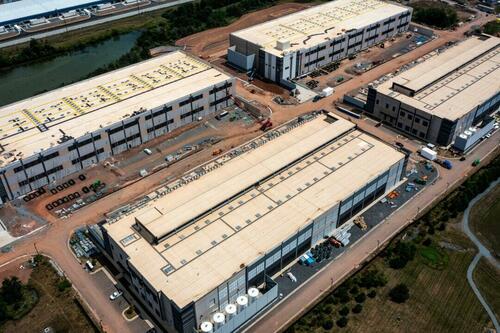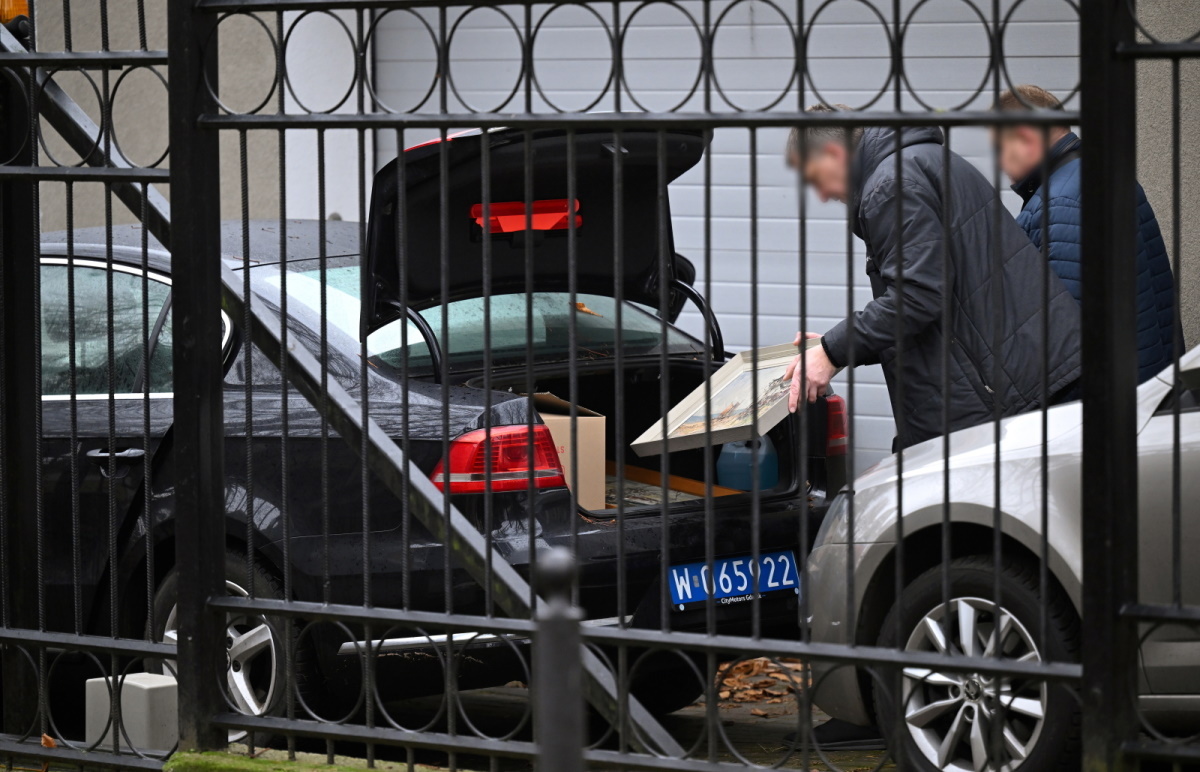![]()
Вашингтон и Силиконовая долина призывают к ядерному возрождению
Автор: Остин Алонзо, The Epoch Times (выделено нами),
Появление облачных вычислений в начале 2000-х годов и генеративных искусственных технологий в 2020-х годах экспоненциально увеличило спрос технологической отрасли США на электроэнергию.
 С высоты птичьего полета дата-центр Amazon Web Services можно увидеть в Стоун-Ридж, штат Вирджиния, 17 июля 2024 года. Натан Ховард / Getty Images
С высоты птичьего полета дата-центр Amazon Web Services можно увидеть в Стоун-Ридж, штат Вирджиния, 17 июля 2024 года. Натан Ховард / Getty ImagesВ ближайшие десятилетия, Крупным дата-центрам, которые обеспечивают энергией новые технологии, потребуется гораздо больше энергии, чем они потребляют в настоящее время.
В 2035 году дата-центры в США будут потреблять в 30 раз больше энергии, чем сейчас. Правительственные чиновники и технологические гиганты делают большие ставки на некогда злополучный источник энергии: ядерную энергию.
Новые федеральные директивы и миллиарды долларов корпоративных инвестиций направлены на то, чтобы быстро вывести ядерные реакторы следующего поколения в интернет, изменив энергетический баланс США и переписав его правила.
Центр обработки данных
С момента запуска Amazon Web Services в 2006 году решения для облачных вычислений и хранения данных произвели революцию в том, как мир работает, учится и играет. Но быстрый рост центров обработки данных, которые управляют услугами, создает невероятный спрос на электроэнергию.
В апрельском отчете группа авторов из Deloitte, возглавляемая исполнительным директором Кейт Хардин, заявила, что в настоящее время центры обработки данных в США используют около 33 гигаватт электроэнергии в год (достаточно для питания около 27,5 миллионов домов в США). Согласно прогнозам, к 2035 году этот спрос вырастет до 176 ГВт.
"Ядерная энергетика представляет собой потенциальное решение для удовлетворения некоторых растущих потребностей в электроэнергии центров обработки данных с его надежным и чистым профилем энергии.Хардин и ее соавторы написали.
В настоящее время, говорится в докладе Deloitte, ядерная энергетика уже превышает свой вес с точки зрения производства электроэнергии. Ядерные объекты в Соединенных Штатах обеспечили более 19 процентов электроэнергии в США в 2024 году, представляя менее 8 процентов от общей генерирующей мощности.
В 2023 году ископаемое топливо генерировало 60 процентов электроэнергии страны, ядерная энергия генерировала около 19 процентов, а такие источники, как ветер и гидроэнергетика, производили около 21 процента.
В июле генеральный директор Amazon Web Services Мэтт Гарман присоединился к президенту Дональду Трампу на мероприятии в Питтсбурге, чтобы рассказать об инвестициях компании в размере 20 миллиардов долларов в штате Кейстоун. Одним из пунктов этого плана является размещение нового кампуса центра обработки данных в поселке Салем, недалеко от атомной электростанции Talen Energy Susquehanna в округе Лузерн, штат Пенсильвания.
Amazon активно инвестирует в атомную энергетику. В заявлении, опубликованном в мае, он назвал ядерную энергию «безопасным, безуглеродным источником энергии, который можно масштабно вывести в интернет». "
Компания заявила, что потратила более 1 миллиарда долларов на проекты и технологии в области ядерной энергетики.
Представители ведущих провайдеров облачных сервисов Amazon, Microsoft и Google либо отказались, либо не ответили на запрос о комментарии The Epoch Times.
Однако в сентябре 2024 года вице-президент Microsoft по энергетике Бобби Холлис заявил, что компания подписала соглашение о покупке электроэнергии с энергетической компанией Constellation, которое позволит перезапустить ядерный объект мощностью 835 мегаватт в Лондондерри, штат Пенсильвания, который был полностью выведен из эксплуатации в 2019 году.
В заявлении Холлис сказал, что этот шаг является частью приверженности компании стать «углеродно-отрицательной компанией». "
28 марта 1979 года реактор энергоблока No 2 на острове Три-Майл потерпел частичный ядерный расплав. В то время как никто не погиб в результате инцидента, это считается самой страшной аварией в истории коммерческой атомной электростанции США.
Несмотря на оптимизм ведущих поставщиков облачных услуг, атомная энергетика в настоящее время является самым маленьким компонентом энергетического баланса США.
В настоящее время в стране работает 94 ядерных реактора, говорится в докладе Deloitte. Этим реакторам в среднем около 40 лет.
Учитывая текущие темпы технического обслуживания и расширения, Deloitte подсчитала, что к 2025 году ядерная энергия обеспечит около 10 процентов общего прогнозируемого спроса на электроэнергию в центрах обработки данных в Соединенных Штатах.
Представители Министерства энергетики, которые говорили с The Epoch Times, заявили, что ядерная инфраструктура страны, вероятно, значительно превысит эти прогнозы в течение следующего десятилетия, особенно сейчас, когда Вашингтон требует быстрого расширения ядерных генерирующих мощностей.
политическая воля
23 мая Трамп подписал четыре указа, которые, как заявил Белый дом, «успокаиваются в ядерном возрождении». "
Приказы призывают к агрессивному расширению производства ядерной энергии в Соединенных Штатах и ставят цель к 2040 году увеличить мощности по производству ядерной энергии в четыре раза.
Они призывают к 2030 году ввести в эксплуатацию 10 новых крупных реакторов, а также ускорить разработку технологий ядерных реакторов, использование ядерной энергии для инфраструктуры искусственного интеллекта и военных объектов, а также ускорить строительство и испытания передовых ядерных реакторов.
Один из приказов также пересматривает Комиссию по ядерному регулированию, называя это провалом. Реформы направлены на ускорение одобрения регулирующих органов и обновление моделей безопасности. Комиссия была создана Конгрессом в 1978 году для обеспечения безопасного использования радиоактивных материалов. В приказе говорится, что с момента его создания в сеть поступили только два новых реактора.
Вместо того чтобы эффективно продвигать безопасную и богатую ядерную энергию, Комиссия по ядерному регулированию вместо этого попыталась изолировать американцев от самых отдаленных рисков без надлежащего учета серьезных внутренних и геополитических издержек такого неприятия риска.- говорится в приказе.
В интервью The Epoch Times высокопоставленный чиновник Управления ядерной энергетики Министерства энергетики США сказал, что исполнительные приказы уже выплачивают дивиденды.
Чиновник подчеркнул недавние объявления о государственно-частном партнерстве, посвященные малым модульным реакторам. В этих партнерских отношениях с Министерством энергетики участвуют такие компании, как Amazon, Dow, X-Energy Reactor Co. и TerraPower.
В настоящее время Министерство энергетики выделило 800 миллионов долларов на финансирование первоначального развертывания малых модульных реакторов. Эти меньшие версии ядерных реакторов предназначены для строительства за пределами площадки и быстрого развертывания на электростанциях.
Чтобы еще больше ускорить разработку новых технологий реакторов, высокопоставленный чиновник сказал, что Министерство энергетики установило испытательный стенд в Национальной лаборатории Айдахо в Айдахо-Фолс, штат Айдахо. Там реакторы могут быть протестированы по разрешению DOE. В июле Национальная лаборатория Айдахо объявила, что Amazon Web Services и Microsoft участвуют в активных проектах по оптимизации развертывания новых реакторов.
Учитывая требование президента провести испытания по меньшей мере трех новых реакторов к июлю 2026 года, высокопоставленный чиновник сказал, что «определенно очень возможно», что по крайней мере один из новых реакторов, испытанных в Национальной лаборатории Айдахо, будет развернут к 2030 году.
Помимо Национальной лаборатории Айдахо, интерес к испытаниям новых реакторных технологий остается высоким. До сих пор Министерство энергетики получает гораздо больше заявок на начало испытаний, чем ожидалось до подписания указов.
Что касается того, чтобы опередить оценку Deloitte, то высокопоставленные чиновники не предоставили конкретных ожиданий относительно того, сколько энергии ядерная будет предоставлять центрам обработки данных в будущем. Тем не менее, они сказали, что если Соединенные Штаты смогут получить 10 крупных, генерирующих ГВт атомных электростанций, строящихся к 2030 году, как того требует исполнительный приказ, то ядерная энергия обеспечит «значительную долю» мощности, необходимой для функционирования центров обработки данных.
Затяжные сомнения
Из-за таких инцидентов, как частичное расплавление острова Три-Майл в 1979 году, расплавление Чернобыля в 1986 году и более поздняя катастрофа на Фукусиме в 2011 году, некоторые экологические активисты выступают против ядерной энергетики.
Представители ведущих групп активистов, таких как Клуб Сьерра, Друзья Земли и Бюллетень ученых-атомщиков, не ответили на запросы о комментариях от The Epoch Times.
В своей последней статье по этому вопросу Бюллетень поставил под сомнение "может ли вмешательство правительства создать новые ядерные реакторы, построенные на временной шкале [искусственного интеллекта], без ущерба для безопасности или повторения прошлых ошибок. "
Выступая 22 июля перед подкомитетом по экономическому росту, энергетической политике и вопросам регулирования Комитета по надзору Палаты представителей, бывший председатель Комиссии по ядерному регулированию Стивен Бернс подверг резкой критике реформы администрации Трампа, которые, по его словам, подрывают независимость агентства и могут поставить под угрозу безопасность.
"Необходимо уделять большое внимание упорядочению процессов лицензирования и регулирования, с тем чтобы исключить подрыв стандартов ядерной безопасности.- сказал Бернс. "Ядерная безопасность, а не ускорение регулирования, должна быть основой этих усилий. "
Несмотря на историю громких аварий, опрос общественного мнения от Gallup и Pew показывает, что американцы в целом поддерживают ядерную энергетику.
Последний опрос, опубликованный Gallup в апреле, показал, что 61% респондентов заявили, что они выступают за «использование ядерной энергии в качестве одного из способов обеспечения электроэнергией». "
Министерство энергетики считает атомные электростанции одним из самых безопасных способов производства электроэнергии. Даже страны, которые ранее запретили ядерную энергетику, в том числе Германия, которая списала свой последний завод в 2023 году, «озадачиваются» этим решением.
Высокопоставленный чиновник признал, что получить новую власть в Интернете будет сложно, но повторил комментарии министра энергетики Криса Райта.
«Это Америка», — сказал Райт в интервью телеканалу Fox News 22 июля. «Мы отправляем людей на Луну. Можно ли снова строить ядерные реакторы? Абсолютно.
"Будет ли это вызовом? Нужно ли что-то менять, чтобы этот мяч снова закрутился? Да. Но можем ли мы это сделать? Да, мы можем, и да, мы будем. "
Тайлер Дерден
Свадьба, 08/13/2025 - 08:05















